An Evaluation System to Optimize the Management of Interventions in the Historic Center of Florence World Heritage Site: From Building Preservation to Block Refurbishment
Abstract
1. Introduction
2. Materials and Methods
2.1. Cultural Heritage and Urban Development Threats
2.2. Cultural Heritage Assessment Tools
2.3. Projects to Safeguard the Historic Center of Florence
- Drafting and monitoring the Management Plan required by the World Heritage Convention in order to promote the conservation, enhancement, and sustainable Management of the Historic Center of Florence;
- Activation and coordination of effective links between public and private actors and stakeholders operating in the Historic Center of Florence;
- Concerted identification of guidelines and joint action projects to be included in the Management Plan and verification of their progress; co-ordination of the management of the funding allocated to the Management Plan and the related Action Plan;
- Periodic reporting on the state of conservation of the Historic Center and changes to the Management Plan and Action Plan;
- Organization of cultural initiatives and celebrations of centenaries related to the historical identity of the city of Florence;
- Promotion, realization, and coordination of studies and research on the history of the city, the territory, and the monumental heritage;
- Implementation and monitoring of projects financed by Law No. 77 of 20 February 2006 ‘Special measures for the protection and enjoyment of Italian sites of cultural, landscape and environmental interest included in the “World Heritage List”, under the protection of UNESCO;
- Consolidation, through specific projects, of transnational cooperation and collaborations between the UNESCO World Heritage Sites and the sister cities of Florence;
- Collaboration in projects aimed at strengthening the management skills of public bodies and associations in the management of World Heritage List sites.
- Verification of the coherence of the project, both with respect to the mission of the site and with respect to the maintenance of its OUV (verification carried out during the selection phase of strategic projects);
- Checks the progress of projects, establishes monitoring indicators, and verifies whether the project objectives are achieved on time.
- Maintenance and prevention: the monitoring of interventions carried out on the architectural heritage makes it possible to schedule future inspections or interventions, setting alarms when the maximum time between one inspection and the next is exceeded;
- Management of cities of art: it is possible to know the economic needs for maintenance and restoration work on building facades;
- Planning: it is possible to know and visualize intervention priorities in order to consciously plan maintenance actions;
- Urban decoration: the chromatic survey of backgrounds, cornices, and plinths makes it possible to develop appropriate methodologies for the conservation and enhancement of building façades with the identification of color matrices and palettes, and textural prototypes.
2.4. About the Method
- The answer to each question has more than one component requiring different evaluation methods;
- An attempt is made to increase the accuracy and consistency of the results;
- There are several steps in the evaluation process and the results obtained by one method are useful for the next steps.
- Definition of a degradation index (DID) specific for elevations and roofs, referring to each building as a stand-alone;
- Creation of an opportunity matrix (DMO) that relates possible interventions on the elevations and roofs of the buildings constituting a block.
- Definition of the degradation index for elevations and roofs (DID)—referring to individual buildings.
- 2.
- Definition of the opportunity matrix (DMO)—consider the set of buildings related to each other.
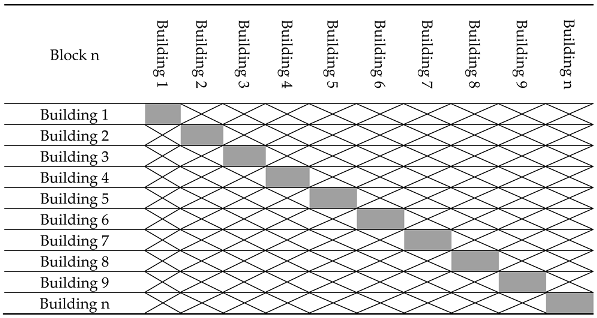
 No operational connection—Idtot buildings between levels 0 and 1.
No operational connection—Idtot buildings between levels 0 and 1. Weak operational connection—Idtot buildings between levels 1 and 2.
Weak operational connection—Idtot buildings between levels 1 and 2. Medium operational connection—Idtot buildings between levels 2 and 3.
Medium operational connection—Idtot buildings between levels 2 and 3. Strong operational connection—Idtot buildings between levels 3 and 4.
Strong operational connection—Idtot buildings between levels 3 and 4. No technological connection—no structural connection between buildings.
No technological connection—no structural connection between buildings. Weak technological connection—a structural connection between buildings but no presence of a site area.
Weak technological connection—a structural connection between buildings but no presence of a site area. Medium technological connection—a structural connection between buildings and the presence of a site area only available on public property (i.e., public street sidewalk).
Medium technological connection—a structural connection between buildings and the presence of a site area only available on public property (i.e., public street sidewalk). Strong connection—a structural connection between buildings and the presence of a site area.
Strong connection—a structural connection between buildings and the presence of a site area.3. Results
3.1. Step 1—Calculation of Roof and Elevation Degradation Index
3.1.1. Kd Factor
3.1.2. Calculation Factor Kc
3.1.3. Idtot Calculation
3.1.4. Definition of the Operational Connection Matrix

4. Discussion and Conclusions
Author Contributions
Funding
Data Availability Statement
Conflicts of Interest
| 1 | Area where the storage of construction materials and means of construction must take place. It must be located within the construction site in open areas allowing easy access for the means of unloading materials and must not be in the way of other work on the construction site. It must also be a common area and connected to both buildings being worked on. |
References
- Firenze Patrimonio Mondiale. Available online: https://www.firenzepatrimoniomondiale.it/ (accessed on 13 March 2023).
- Il Terzo Piano di Gestione e i Piani Precedenti. Firenze Patrimonio Mondiale. Available online: https://www.firenzepatrimoniomondiale.it/il-piano-di-gestione-2021-2022-e-piani-di-gestione-precedenti/ (accessed on 13 March 2023).
- HeRe_Lab—Heritage Research | Firenze Patrimonio Mondiale. Available online: https://www.firenzepatrimoniomondiale.it/here_lab-heritage-research/ (accessed on 13 March 2023).
- Prieto, A.J.; Macías-Bernal, J.M.; Silva, A.; Ortiz, P. Fuzzy Decision-Support System for Safeguarding Tangible and Intangible Cultural Heritage. Sustainability 2019, 11, 3953. [Google Scholar] [CrossRef]
- Di Matteo, E.; Roma, P.; Zafonte, S.; Panniello, U.; Abbate, L. Development of a Decision Support System Framework for Cultural Heritage Management. Sustainability 2021, 13, 7070. [Google Scholar] [CrossRef]
- HECO (HEritage COlors). Available online: https://www.firenzepatrimoniomondiale.it/progetti/heco-heritage-colours/ (accessed on 13 March 2023).
- United Nations; Educational, Scientific and Cultural Organization. The 2005 Convention on the Protection and Promotion of the Diversity of Cultural Expressions. Available online: https://en.unesco.org/creativity/sites/creativity/files/passeport-convention2005-web2.pdf (accessed on 12 March 2023).
- United Nations Conference on Sustainable Development, Rio+20: Sustainable Development Knowledge Platform. Available online: https://sustainabledevelopment.un.org/rio20 (accessed on 30 December 2022).
- Key Action City of Tomorrow and Cultural Heritage|Programme | FP5 | CORDIS | European Commission. Available online: https://cordis.europa.eu/programme/id/FP5-EESD_1.1.4.-4./it (accessed on 30 December 2022).
- Sustainable Development Goals | United Nations Development Programme. Available online: https://www.undp.org/sustainable-development-goals (accessed on 30 December 2022).
- UNESCO World Heritage Centre. State of Conservation (SOC). Available online: https://whc.unesco.org/en/soc/ (accessed on 30 December 2022).
- Rodwell, D. The Unesco World Heritage Convention, 1972–2012: Reflections and Directions. Hist. Environ. Policy Pract. 2012, 3, 64–85. [Google Scholar] [CrossRef]
- Patiwael, P.R.; Groote, P.; Vanclay, F. Improving Heritage Impact Assessment: An Analytical Critique of the ICOMOS Guidelines. Int. J. Herit. Stud. 2019, 25, 333–347. [Google Scholar] [CrossRef]
- Nita, A.; Fineran, S.; Rozylowicz, L. Researchers’ Perspective on the Main Strengths and Weaknesses of Environmental Impact Assessment (EIA) Procedures. Environ. Impact Assess. Rev. 2022, 92, 106690. [Google Scholar] [CrossRef]
- Directive 2014/52/EU of the European Parliament and of the Council of 16 April 2014 Amending Directive 2011/92/EU on the Assessment of the Effects of Certain Public and Private Projects on the Environment Text with EEA Relevance. Available online: https://eur-lex.europa.eu/legal-content/EN/TXT/?uri=celex%3A32014L0052 (accessed on 13 March 2023).
- Silva, A.; Roders, A. Cultural Heritage Management and Heritage (Impact) Assessments. Proc. Jt. CIB W 2012, 70, W092. [Google Scholar]
- Rossitti, M.; Oppio, A.; Torrieri, F. The Financial Sustainability of Cultural Heritage Reuse Projects: An Integrated Approach for the Historical Rural Landscape. Sustainability 2021, 13, 13130. [Google Scholar] [CrossRef]
- ICOMOS. Guidance on Heritage Impact Assessments for Cultural World Heritage Properties; ICOMOS: Paris, France, 2011. [Google Scholar]
- Ashrafi, B.; Neugebauer, C.; Kloos, M. A Conceptual Framework for Heritage Impact Assessment: A Review and Perspective. Sustainability 2021, 14, 27. [Google Scholar] [CrossRef]
- Cucco, P.; Maselli, G.; Nesticò, A.; Ribera, F. An Evaluation Model for Adaptive Reuse of Cultural Heritage in Accordance with 2030 SDGs and European Quality Principles. J. Cult. Herit. 2023, 59, 202–216. [Google Scholar] [CrossRef]
- Sukwai, J.; Mishima, N.; Srinurak, N. Balancing Cultural Heritage Conservation: Visual Integrity Assessment to Support Change Management in the Buffer Zone of Chiang Mai Historic City Using GIS and Computer-Generated 3D Modeling. Land 2022, 11, 666. [Google Scholar] [CrossRef]
- Jiménez-Espada, M.; Cuartero, A.; Breton, M.L. Sustainability Assessment through Urban Accessibility Indicators and GIS in a Middle-Sized World Heritage City: The Case of Cáceres, Spain. Buildings 2022, 12, 813. [Google Scholar] [CrossRef]
- Ferretti, V.; Bottero, M.; Mondini, G. Decision Making and Cultural Heritage: An Application of the Multi-Attribute Value Theory for the Reuse of Historical Buildings. J. Cult. Herit. 2014, 15, 644–655. [Google Scholar] [CrossRef]
- Sevieri, G.; Galasso, C. Typhoon Risk and Climate-Change Impact Assessment for Cultural Heritage Asset Roofs. Struct. Saf. 2021, 91, 102065. [Google Scholar] [CrossRef]
- Egusquiza, A.; Brostrom, T.; Izkara, J.L. Incremental Decision Making for Historic Urban Areas’ Energy Retrofitting: EFFESUS DSS. J. Cult. Herit. 2022, 54, 68–78. [Google Scholar] [CrossRef]
- Acampa, G.; Francini, C.; Grasso, M. Study of the Cloisters of the Historical Center of Florence: Methodological Approach for the Definition of Restoration Intervention Priorities; Springer: Berlin, Germany, 2022; pp. 2587–2596. [Google Scholar]
- Sesana, E.; Gagnon, A.S.; Ciantelli, C.; Cassar, J.; Hughes, J.J. Climate Change Impacts on Cultural Heritage: A Literature Review. Wiley Interdiscip. Rev. Clim. Chang. 2021, 12, e710. [Google Scholar] [CrossRef]
- Etxano, I.; Villalba-Eguiluz, U. Twenty-Five Years of Social Multi-Criteria Evaluation (SMCE) in the Search for Sustainability: Analysis of Case Studies. Ecol. Econ. 2021, 188, 107131. [Google Scholar] [CrossRef]
- Oppio, A.; Dell’Ovo, M. Cultural Heritage Preservation and Territorial Attractiveness: A Spatial Multidimensional Evaluation Approach. In Cycling & Walking for Regional Development; Pileri, P., Moscarelli, R., Eds.; Research for Development; Springer International Publishing: Cham, Switzerland, 2021; pp. 105–125. ISBN 978-3-030-44002-2. [Google Scholar]
- Bottero, M.; D’Alpaos, C.; Oppio, A. Ranking of Adaptive Reuse Strategies for Abandoned Industrial Heritage in Vulnerable Contexts: A Multiple Criteria Decision Aiding Approach. Sustainability 2019, 11, 785. [Google Scholar] [CrossRef]
- Acampa, G.; Parisi, C.M. Cultural Heritage Management: Optimising Procedures and Maintenance Costs. Valori Valutazioni 2021, 29, 79–102. [Google Scholar] [CrossRef]
- Bosone, M.; De Toro, P.; Fusco Girard, L.; Gravagnuolo, A.; Iodice, S. Indicators for Ex-Post Evaluation of Cultural Heritage Adaptive Reuse Impacts in the Perspective of the Circular Economy. Sustainability 2021, 13, 4759. [Google Scholar] [CrossRef]
- Acampa, G.; Battisti, F.; Di Pietro, G.; Parisi, C.M. City Information Model for the Optimization of Urban Maintenance Cost; AIP Publishing LLC: Woodbury, NY, USA, 2021; Volume 2343, p. 090002. [Google Scholar]
- Romão, X.; Bertolin, C. Risk Protection for Cultural Heritage and Historic Centres: Current Knowledge and Further Research Needs. Int. J. Disaster Risk Reduct. 2022, 67, 102652. [Google Scholar] [CrossRef]
- UNESCO World Heritage Centre. UNESCO World Heritage Centre—Sessions. Available online: https://whc.unesco.org/en/sessions/?pattern=&year=1982 (accessed on 30 December 2022).
- Francioni, F.; Lenzerini, F. The 1972 World Heritage Convention. A Commentary; Oxford University Press: Oxford, UK, 2008; ISBN 0-19-929169-1. [Google Scholar]
- De Luca, G.; Shirvani Dastgerdi, A.; Francini, C.; Liberatore, G. Sustainable Cultural Heritage Planning and Management of Overtourism in Art Cities: Lessons from Atlas World Heritage. Sustainability 2020, 12, 3929. [Google Scholar] [CrossRef]
- Centauro, G.; Francini, C. (Eds.) Progetto HECO (Heritage Colors): Metodologie, Analisi, Sintesi, Apparati, Valutazione d’impatto Sul Sito UNESCO Centro Storico Di Firenze; Ricerche; DidaPress: Florence, Italy, 2017; ISBN 978-88-96080-92-4. [Google Scholar]
- Capitanio, C.; Chiesi, D.; Franco, M. Florence Heritage Data System. Un Modello Di Controllo e Valutazione per i Siti Patrimonio Mondiale. Restauro Archeol. 2022, 30. [Google Scholar] [CrossRef]
- Taylor, K.; Verdini, G. Management Planning for Cultural Heritage: Places and Their Significance; Routledge: Abingdon-on-Thames, UK, 2022; ISBN 1-315-71848-0. [Google Scholar]
- Brumann, C.; Gfeller, A.É. Cultural Landscapes and the UNESCO World Heritage List: Perpetuating European Dominance. Int. J. Herit. Stud. 2022, 28, 147–162. [Google Scholar] [CrossRef]
- Centauro, G.A. Tecnologie e Conservazione degli Apparati Pittorici e del Colore Nell’edilizia Storica; Università degli Studi di Firenze: Florence, Italy, 2008; ISBN 978-88-95798-09-7. [Google Scholar]
- Forte, F.; Del Giudice, V.; De Paola, P.; Troisi, F. Valuation of the Vocationality of Cultural Heritage: The Vesuvian Villas. Sustainability 2020, 12, 943, Erratum in Sustainability 2020, 12, 2069. [Google Scholar] [CrossRef]
- Nicolella, M. Programmazione degli Interventi in Edilizia: Guida al Libretto di Manutenzione del Fabbricato; UNI: Milano, Italy, 2003; ISBN 978-88-87777-49-9. [Google Scholar]
- Nicolai, R.P.; Dekker, R. Optimal Maintenance of Multi-Component Systems: A Review. In Complex System Maintenance Handbook; Springer Series in Reliability Engineering; Springer: London, UK, 2008; pp. 263–286. ISBN 978-1-84800-010-0. [Google Scholar]
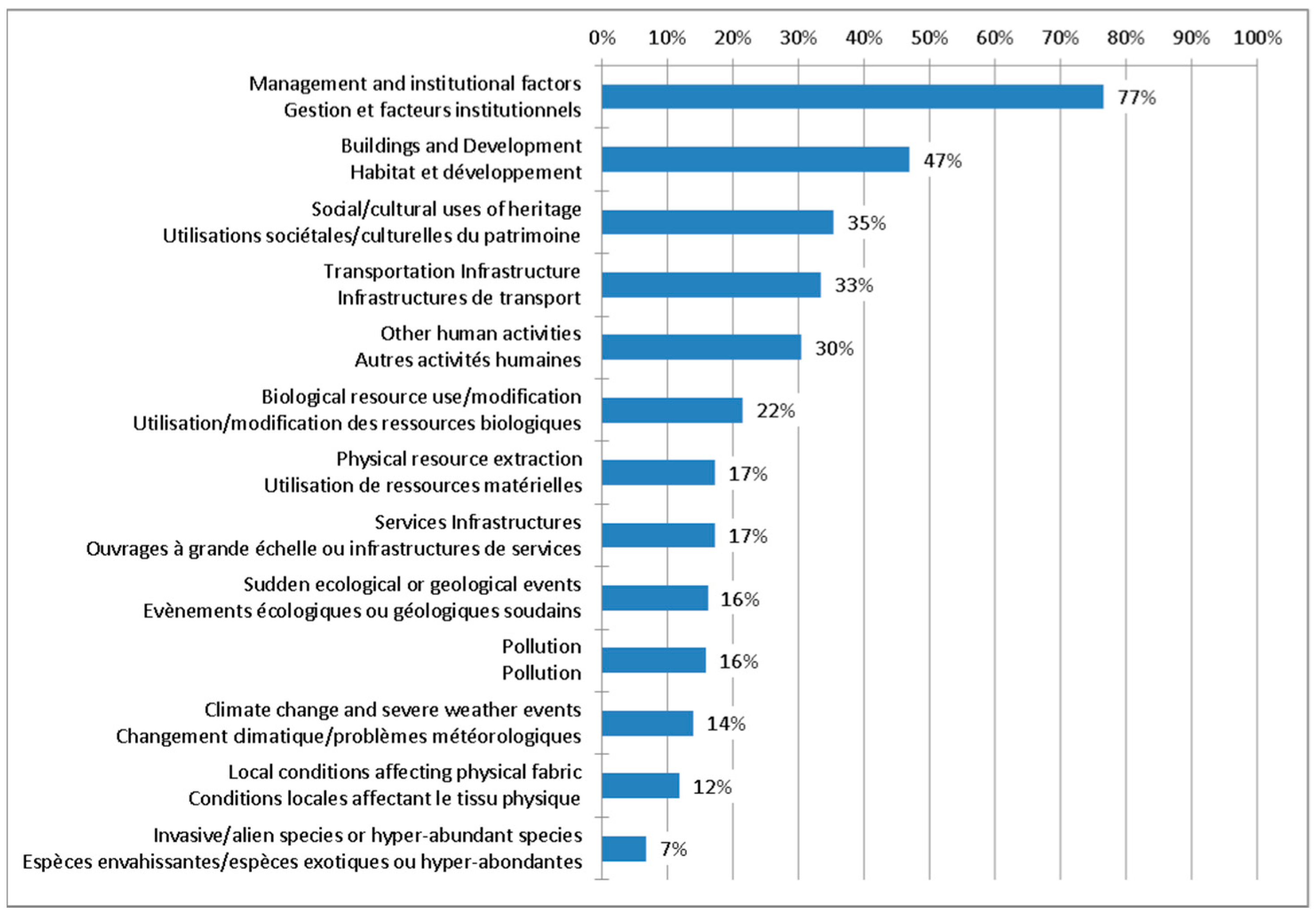
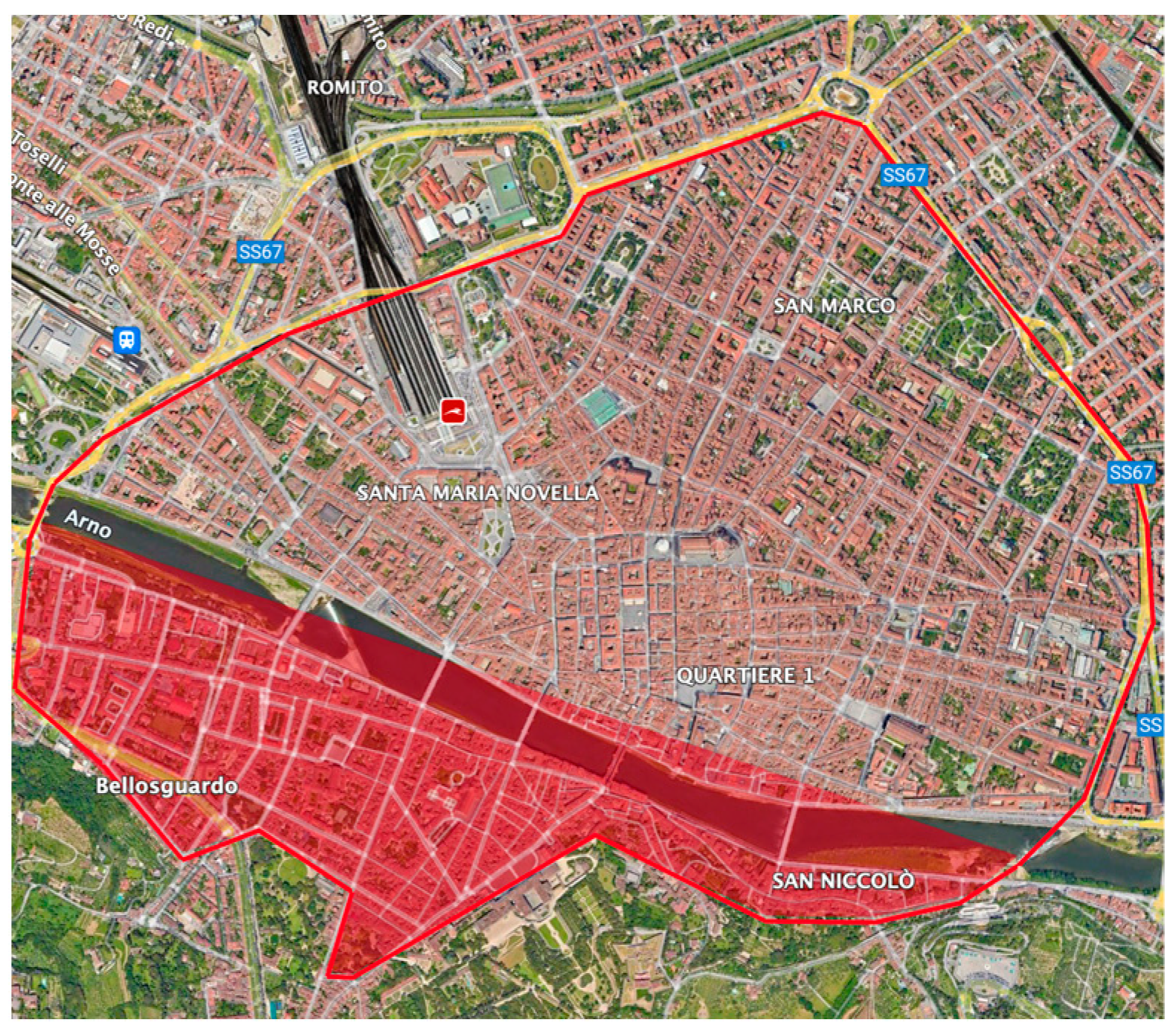
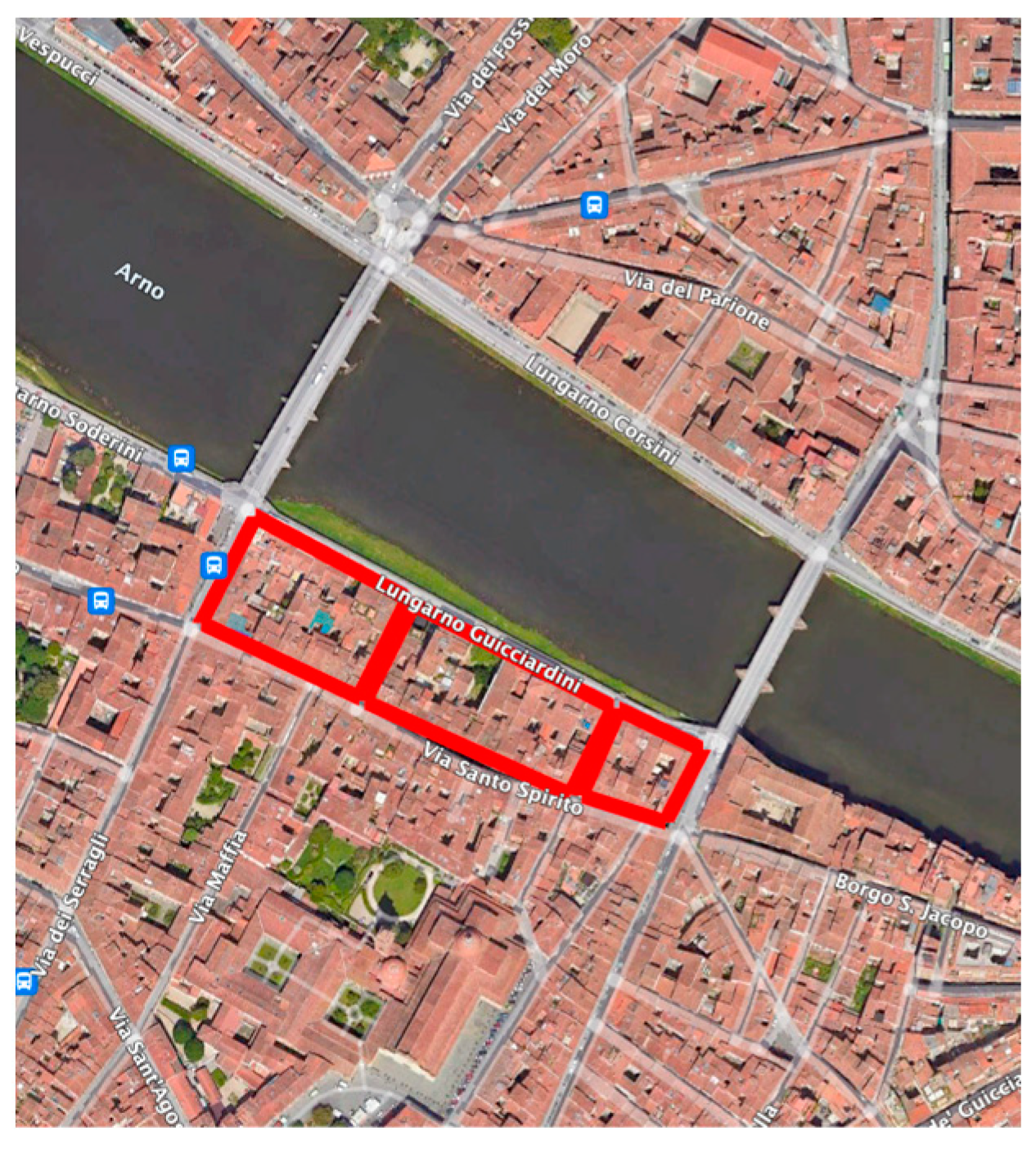

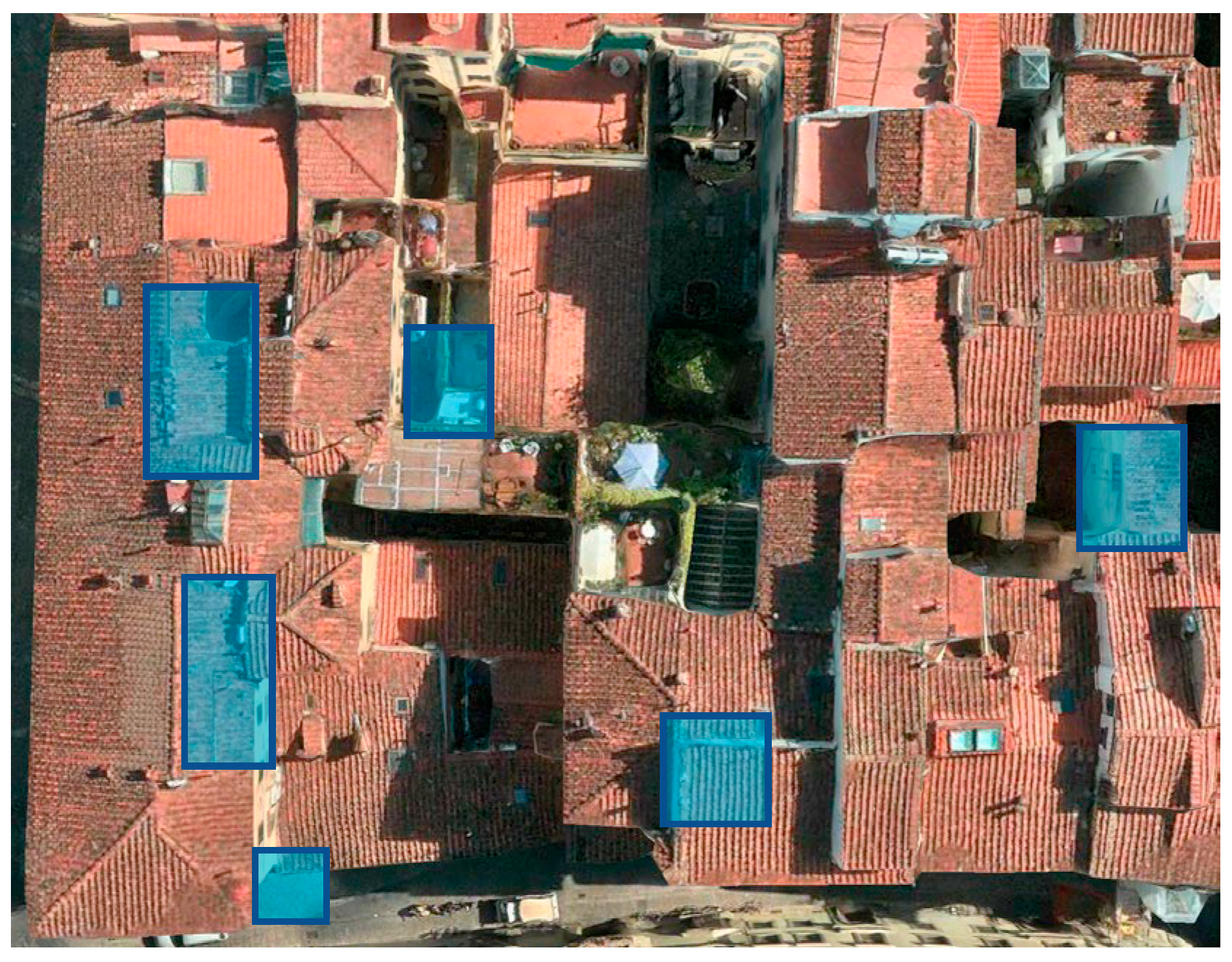
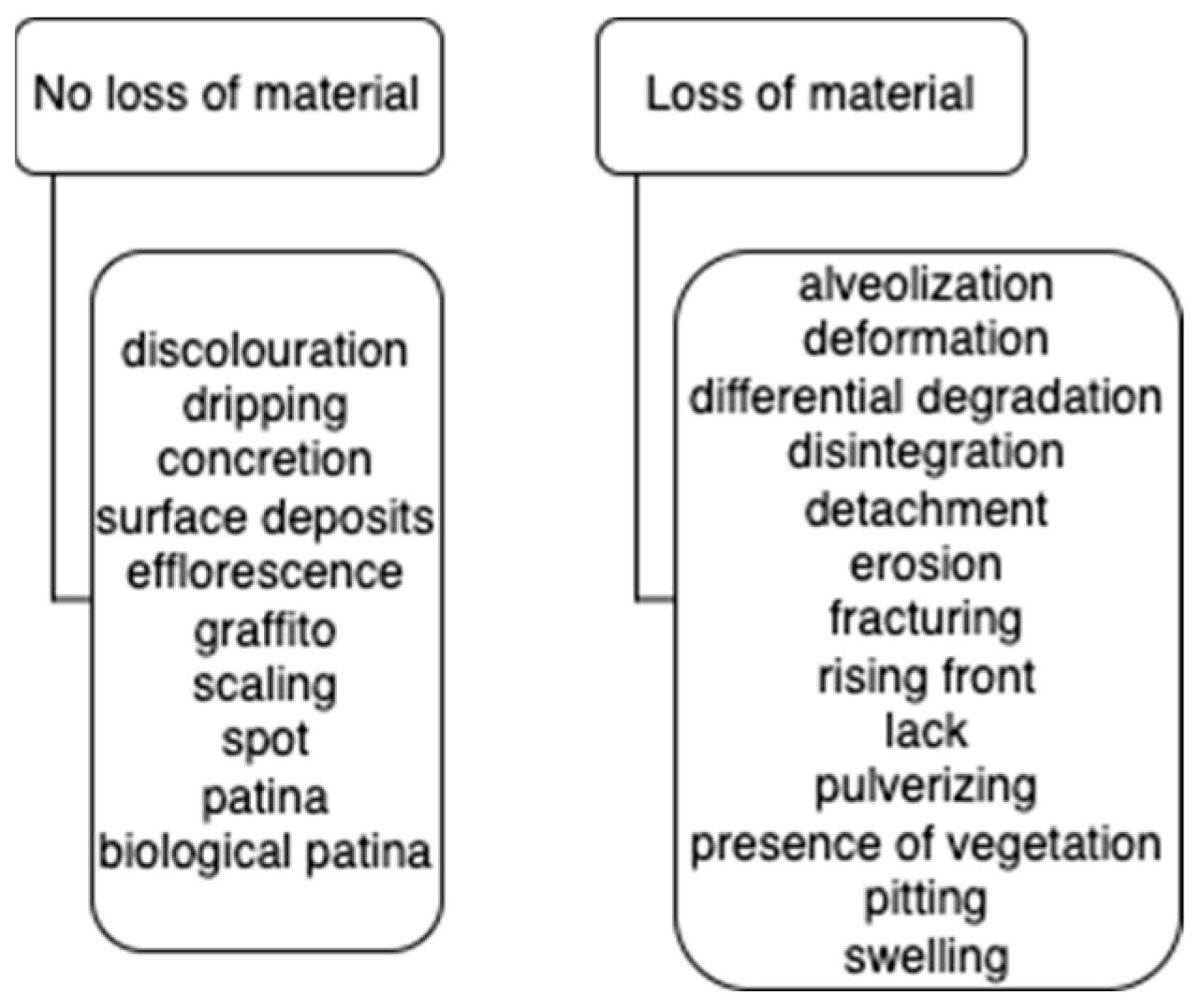
| Idtot = 0 | Level 0 | No degradation |
| 0 < Idtot | Level 1 | Good condition |
| 4 < Idtot | Level 2 | Light degradation |
| 8 < Idtot | Level 3 | Moderate degradation |
| 12 < Idtot | Level 4 | Widespread degradation |
| Light | Medium | Severe | Extremely Severe |
|---|---|---|---|
| 1 | 2 | 3 | 4 |
| Discoloration Dripping Graffito Spot Patina | Biological patina Surface deposit Efflorescence Scaling Concretion | Alveolization Differential degradation Disintegration Erosion Fracturing Rising front Pulverizing | Deformation Detachment Exfoliation Swelling |
| 1, 2: no loss of material | 3, 4: loss of material | ||
| Degradation | Loss of Material | Intervention Category | Intervention Procedure for Stone Materials | Intervention Costs for Stone Materials | Intervention Procedure for Wood Materials | Intervention Cost for Wood Materials |
|---|---|---|---|---|---|---|
| Discoloration, Dripping, Graffito, Spot, Patina | No | Simple cleaning | Cleaning with low-pressure deionized water | EUR 58.98/mq | Cleaning for loose dirt | EUR 57.98/mq |
| Concretion, Scaling, Surface deposit, Efflorescence, Biological Patina | No | Complex cleaning | Cleaning with compresses and tools | EUR 61.98/mq | Cleaning with a tool | EUR 64.84/mq |
| Alveolization, Differential Degradation, Disintegration, Erosion, Fracturing, Rising front, Pulverizing | Yes | Integration | 1. Removal of non-compatible parts 2. Surface cleaning 3. Stone element grouting 4. Finishing | EUR 215,35/mq | Integrations of wooden parts without inlays or decoration | EUR 53.67/mq |
| Deformation, Detachment, Exfoliation, Swelling | Yes | Consolidation | EUR 480,88/mq | Consolidation of an unpainted wooden structure | EUR 139.75/mq |
| Intervention Category | Stone | Wood |
|---|---|---|
| No intervention | 0 | 0 |
| Simple cleaning | 0.18 | 0.48 |
| Complex cleaning | 0.22 | 0.54 |
| Material integration | 0.76 | 0.45 |
| Material consolidation | 1.71 | 1.16 |
| Material replacement | 1 (280.81 €/mq) | 1 (119.98 €/mq) |
Disclaimer/Publisher’s Note: The statements, opinions and data contained in all publications are solely those of the individual author(s) and contributor(s) and not of MDPI and/or the editor(s). MDPI and/or the editor(s) disclaim responsibility for any injury to people or property resulting from any ideas, methods, instructions or products referred to in the content. |
© 2023 by the authors. Licensee MDPI, Basel, Switzerland. This article is an open access article distributed under the terms and conditions of the Creative Commons Attribution (CC BY) license (https://creativecommons.org/licenses/by/4.0/).
Share and Cite
Acampa, G.; Battisti, F.; Grasso, M. An Evaluation System to Optimize the Management of Interventions in the Historic Center of Florence World Heritage Site: From Building Preservation to Block Refurbishment. Land 2023, 12, 726. https://doi.org/10.3390/land12040726
Acampa G, Battisti F, Grasso M. An Evaluation System to Optimize the Management of Interventions in the Historic Center of Florence World Heritage Site: From Building Preservation to Block Refurbishment. Land. 2023; 12(4):726. https://doi.org/10.3390/land12040726
Chicago/Turabian StyleAcampa, Giovanna, Fabrizio Battisti, and Mariolina Grasso. 2023. "An Evaluation System to Optimize the Management of Interventions in the Historic Center of Florence World Heritage Site: From Building Preservation to Block Refurbishment" Land 12, no. 4: 726. https://doi.org/10.3390/land12040726
APA StyleAcampa, G., Battisti, F., & Grasso, M. (2023). An Evaluation System to Optimize the Management of Interventions in the Historic Center of Florence World Heritage Site: From Building Preservation to Block Refurbishment. Land, 12(4), 726. https://doi.org/10.3390/land12040726








